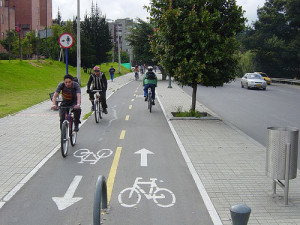Hedonomics and the art of cycling in the city
What makes a city a great place to live? Is it the commute, property prices or good conversation, asks Charles Montgomery, whose book Happy City explores the intersection between urban design and hedonomics, the science of urban happiness.
It helps if a city allows for bicycling and walking, he says. These are gentler modes of travel than cars, rushing monarchs of the road. Bicycles help to connect with the urban landscape at a more intimate level. Getting on your bike and out of the car means going slower, with the notional time to smell the flowers. Montgomery goes on to describe a bicycle trip through the Colombian capital Bogota with its so-called mayor of happiness Enrique Penalosa as he picked up his son from school. “Here, in the heart of one of the meanest, poorest cities in the hemisphere, father and son would roll away from the school gate for a carefree ride across the metropolis,” Montgomery writes.
The sentence sums up the remarkable transformation wrought by Mr Penalosa through his bicycle revolution. It turned a city infamous for narco-terrorism, pollution and chaos into a globally lauded model of livability and urban renewal.
So how did he do it and can it be replicated elsewhere? Back in 2000, Mr Penalosa started car-ban days in Bogota. It resulted in fewer traffic accidents and hospital admissions. He abandoned an ambitious highway expansion plan and poured his budget into hundreds of kilometres of cycle paths and the world’s longest “pedestrian freeway” instead. The toxic haze over the city started to thin and for Bogotans, a metaphorical rainbow appeared in the sky. Many of them would later tell pollsters that they felt more optimistic about city life than in a long time. Years later, when Nairo Quintana finished second in the Tour de France, the best ever showing by a Colombian cyclist in the world’s most famous bike race, Bogota, his home. was reconfirmed as a great biking city.
Bogota’s experience should give pause for thought to anyone concerned about the 20th century’s seemingly immutable legacy – old cities that have been reoriented around cars and newer ones that follow convention and are built to allocate maximum space and leverage to automobiles. Reclaiming urban space for pedestrians and bicyclists (who are really walkers on wheels) is an issue that must concern us all. As of July 2014, the majority of people on this planet live in cities rather than in rural areas and by 2050, the number will increase to a full two-thirds of humankind.
Unsurprisingly, cities around the world are competing to be seen as liveable, and in hip urban-speak, “multigenerational and for life”. What does that mean? Good public transportation, of course, and easy access pretty much everywhere for the old and disabled. Good conversation too, going by Montgomery’s question above. More crucially though, it means the self-assured and happy representation of different age and wage groups in public spaces. That means on roads just as much as in parks, and that car drivers share space with bicyclists and walkers. Urban inclusiveness has to extend to all modes of transport.
Older cities like London, Paris, Hamburg, Berlin and Antwerp have managed part of the transformation to a cycling culture by some or all of the following: painted cycle lanes, separate cycle tracks where feasible, bike-share schemes and cycle parking facilities at key places. Last July, Helsinki announced that it would transform its existing public transport network into a comprehensive, point-to-point “mobility on demand” system by 2025, which would knit together shared bikes, driverless cars, buses and ferries. In theory, the Finnish capital’s planned mobility mesh would be so good nobody would have any particular reason to own a car any more, at least for urban commuting.
So far so bold. But it is the story from Seville, Spain’s fourth largest city that is the most encouraging. Barely eight years ago, the city authorities decided to promote cycling in sheer exasperation at the four-hour long daily rush hour. It was condemned and mocked. Many penetrating questions were asked about who might be lunatic enough to ride through one of Europe’s hottest regions at the height of summer? Would office-goers not prefer to travel in cars and buses and arrive at work cool and fresh rather than damp and sweaty?
The city authorities paid no heed, establishing 80 kilometres of cycle lanes within a year and commissioning a municipal bike rental plan called Sevici. By 2012, bike journeys had gone up from less than 0.5 per cent of all daily trips to about 7 per cent. And Seville now has a cycling culture of sorts.
So it can be done, even in the most unlikely settings so long as a city is daring enough to accept the logic of re-imagining itself. American writer Guy Davenport once described the difference between the Parthenon and the World Trade Center, between Sophocles and Shakespeare and between a bicycle and a horse as thoroughly “explicable by historical moment, necessity, and destiny” but above all, by “a difference of imagination”. Incongruous though it may seem in the digital age, the salvation of cities may lie in the low-tech bicycle. Let’s find out on #CycletoworkUAE day.
On Twitter: @rashmeerl


